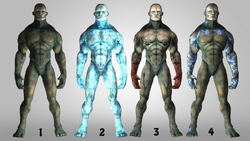| “ | I remember when me and the Kraut put you in that sub. You were no more than two. You were my ace in the hole, but you were also the closest thing I ever had to a son. And that's why this hurts. Betrayal, kid. Life ain't strictly business. | „ |
| ~ Frank Fontaine moments before the final battle against him. |
| “ | Would you kindly. | „ |
| ~ Frank Fontaine's catchphrase as Atlas. |
Frank Fontaine, also known as Atlas, is the main antagonist of both BioShock and BioShock Infinite: Burial at Sea. He is also a major antagonist in the prequel novel BioShock: Rapture. He is a criminal mastermind, crime lord, and con artist that resides in the underwater city of Rapture. Fontaine made himself rich through smuggling and built Fontaine Futuristics, which developed ADAM, the genetic material needed for the manufacturing of plasmids and gene tonics.
He is voiced by Greg Baldwin, who is also the current voice of Aku .
History
Fontaine was a master con artist who was so good at his job that he could even impersonate a "chinaman" for as long as two weeks. He arrived in Andrew Ryan's city of Rapture sometime in 1948 and founded Fontaine Fisheries. However, Fontaine used it as a front for smuggling and selling contraband items from the surface. He grew rich from these practices, and they led him to a new line of business. One of his smugglers discovered a sea slug which regenerated tissue. This caught the attention of a scientist in Rapture named Brigid Tenenbaum, who asked Fontaine to fund her study of the slug. Along with Dr. Yi Suchong, they founded Fontaine Futuristics, which eventually discovered how to reproduce and refine the healing properties of the slug, which became known as ADAM and made the plasmid and gene tonic industries possible. Looking for a way to produce ADAM more quickly, Fontaine opened the Little Sister's Orphanage, where little girls were experimented on and turned into the ADAM producing Little Sisters. Having gained economic dominance in Rapture, Fontaine sought ultimate control. He opened Fontaine's Home for the Poor, and sought to build an army from the masses of people that were victimized by Ryan's free market policies.
On September 12, 1958, Fontaine apparently died in a shootout with Ryan's men, sealing himself the status of a martyr to those who did not know his true nature. In reality he faked his death, hoping to stir up discontent among the lower classes and give Ryan the false hope that his nemesis was dead. He reemerged as Atlas, a fisherman, proletariat hero and family man. His original voice remained, covered for with a heavy Irish accent. He then charismatically charmed the mob as a humble freedom fighter, while setting the stage for the Civil War which would tear Rapture apart. Originally hoping for victory in this genetic arms race, "Atlas" soon found himself trapped in Rapture, with Ryan in control of the bathyspheres and the Splicers through his pheromone systems. With no other way out, "Atlas" activated his sleeper agent, Jack.
When Jack finally reaches Fontaine, he has already spliced himself into a hulking, statuesque monster with three different major Plasmid elements. During the battle, Jack extracts the ADAM out of him with a Little Sister's needle until finally, he is weakened enough that he is ambushed and killed by a swarm of Little Sisters who stab Fontaine multiple times with their needles, draining him of the remaining ADAM in his body.
In his death, Fontaine illustrates Brigid Tenenbaum's realization that excessive ADAM use forces the body into dependency. The ambiguous expression "Keep back the tide" is shown to mean a not only mental but physical degeneration when the body's dependency is denied. Without ADAM, Fontaine's enhanced body simply could not survive.
Trivia
- In the original BioShock, Fontaine uses a recycled splicer model, so he shows deformities even before using Adam. However as he is only seen at a distance, this is meant to go unnoticed. He is eventually given a unique model in Burial at Sea.
- According to Ken Levine, the creative director of BioShock, Fontaine was partially inspired by Keyser Söze, the antagonist of The Usual Suspects. This is evident due to both being crime bosses feared by every criminal, as well as both being seen as "boogeymen".




